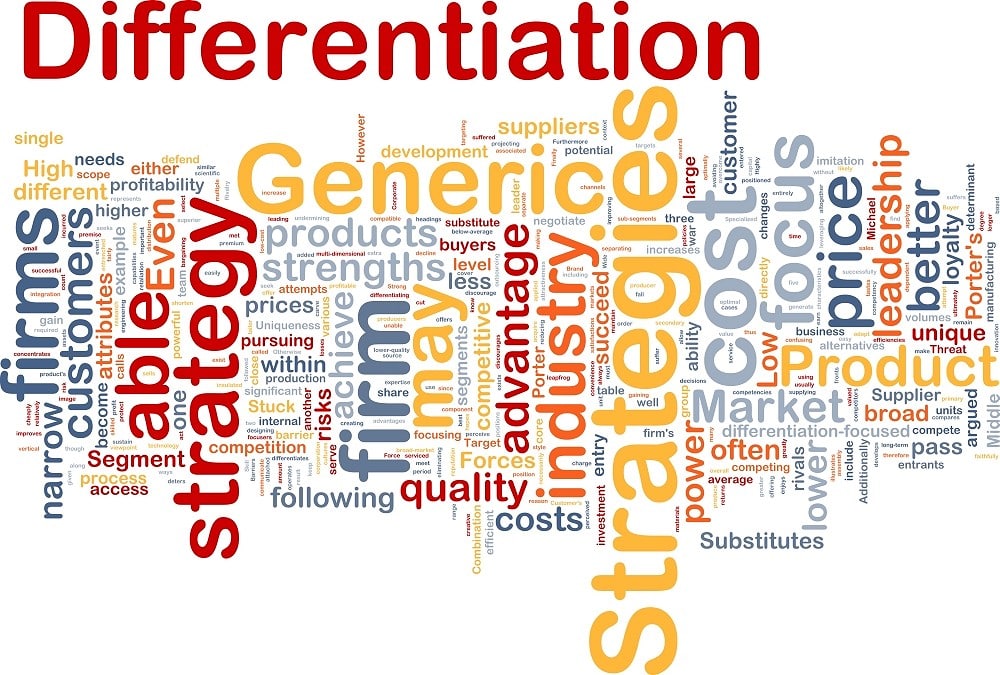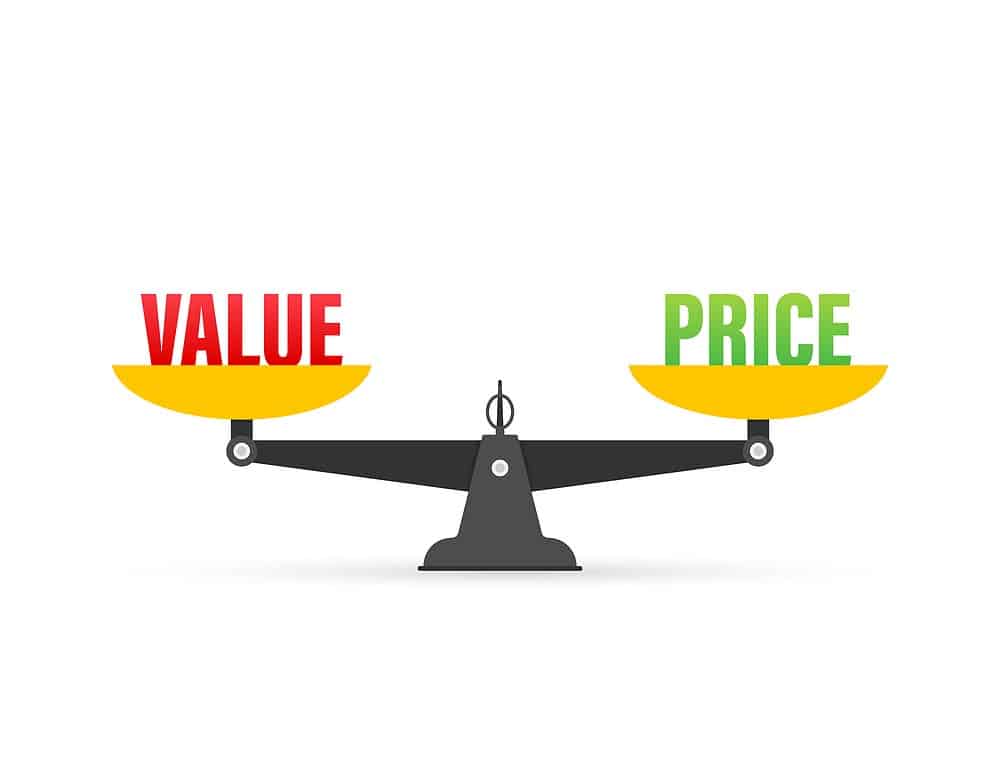
Competitive Based Pricing: Falling Into the Commoditisation Trap? 🏷️
Are you one of them that uses competitive pricing? How sure are you that you’re not falling into the commoditisation trap? Are you in control of profitability or are your competitors the ones driving your profitability?
>Download Now: Free PDF How to Drive Pricing Strategy to Maximise EBIT Growth
Many businesses implement competition based pricing strategies and tactics. The assumption is that, the price of their products and services is set by an equilibrium in the market. Like for instance, that the market will eventually decide the right price for your products and services.
However, applying this traditional economic principle when markets are extremely volatile and highly competitive is fraught with risk. Thus, leading to inevitable margin erosion and commoditisation.
1. Market equilibrium is constantly shifting. Most businesses do not have advanced price analysis and or competitive pricing intelligence systems (or even mindset) to track, monitor and adjust to key shifts in the market.
2. Today’s pricing teams are still largely focused on price administration. In turn, struggle to interpret patterns of variability in the market that would otherwise drive profitability for the business.
3. Business and pricing strategy are oftentimes based on simplistic cost-plus and competitive pricing methodology. Oftentimes, it fails to explain the differences in revenue and margin by product and customer segment.
Classical economic theory was fine when markets were more stable. In 2017 and onwards, we need to adapt our thinking and break away from routine economic and management principles.
In this article, we will evaluate competitive based pricing. Also, identify the possible difficulties you may face as you develop your competitive pricing strategy for each segment and product. We will also provide a series of recommendations and alternatives throughout this article. This will help you and your team think beyond the day to day tactics of competitive pricing setting scenarios.
Table of Contents:
I. Competitive based pricing: Falling into the commoditisation trap?
II. Competition based pricing: Monte Carlo methods in B2B & B2C pricing
III. Competitive Pricing: 7 Steps For Pricing In The Age Of Digital Disruption
IV. How to Create a Competitive Pricing Strategy to Increase Profitability

Competitive based pricing: Falling into the commoditisation trap?
What is competitive based pricing?
Competitive pricing means setting your prices at the same (equivalent/parity pricing), slightly higher or slightly lower than your competitors. Your pricing team will set an initial item price by examining a competitor’s or group of competitors’ prices. This process is known as competition-based pricing.
Competitive based pricing is complex: Coca-Cola Case study
In a highly competitive market, oftentimes, when you start the competitive based pricing process, you will find multiple prices for an item product or service. A large variation in price created by competitive based pricing is otherwise known as price dispersion. An example of price dispersion resulting from competitive pricing is Coca-Cola (see interesting article on the early pricing history of Coke).
Coca-Cola operates in a highly competitive market consisting of similar and substitutable products. Coke as a single item can be bought for $0.59 or nearly as much as $5.00. There are a number of price points for Coke in the marketplace (even between neighbouring retail stores). Yet, the product remains unchanged even after years and years of production.
If we assume that the B2C Coca-Cola pricing team in APAC is implementing competitive based pricing for Coke, then Coke’s competitive pricing process would begin. For instance, by trawling through large amounts of competitive price information and data available to determine the initial price point for competing retailers across multiple segments.
If we also assume that the APAC Coke pricing team does not have pricing software tools to automate their competitive pricing process, then the above competitive pricing process would be largely manual. Requiring pricing analysts to input and change prices weekly or monthly in the system to remain competitive in the market.
The Coca-Cola case study above illustrates the administrative pricing complexity associated with competitive pricing.
We commonly see pricing teams devolving into reactive and operational decision-making.
The reason is, they’re tracking competitors closely that they don’t have time to think about the wider market and positioning. Simply managing price dispersion created by competitive pricing across segments and products will reduce profit.
Key pricing questions: What are the drivers of pricing power for Coke? Does the market really control pricing power for Coke or it is something else driving price?
Resolving pricing complexity with a competitive pricing strategy
Often pricing teams get around the complexity of vast competitive price information by focusing on only the highest marketplace prices. Sometimes, on only the lower or only in the middle of the competitive price range. Some businesses also select a group of competitors and apply the above competitive pricing method of setting their initial prices by product and segment.
In all cases, it is important for pricing teams to supplement their competitive pricing methods with customer and competitor information. Such as costs, strategies, elasticities, profit levels and other elements of competitive pricing intelligence. However, most businesses have large gaps in their data architecture and analytics. They cannot generate meaningful insights on either the customer or the competitor. Consequently, businesses are forced to make assumptions about their competitors and consumer behaviour without fully qualifying and validating this with evidence.
The problem with a competitive pricing strategy
When businesses do not have enough information to supplement and qualify their assumptions on consumer and competitive behaviour, they tend to assume that their competitors are like them. Consequently, pricing options (and understanding of trade-offs) become limited with their own match to market thinking.
However, what if your competitors know even less about the impact of pricing on the market than you? What if they don’t have an accurate gauge on their cost base? What if they do not understand their customer base and or demand pricing and are actually following you? Every business is different in terms of their CAPEX, supply, strategy and vision for the future. Don’t assume your competitors are like you.
〉〉〉 Get Your FREE Pricing Audit 〉〉〉
Conclusion
Competitive based pricing strategy and tactics can often miss the subtle variations in the market. In turn, don’t always account for the differences in revenue, contribution margin, cost to serve, value by segment and product.
A highly manual competitive pricing process and static pricing model based on basic market assumptions and arbitrary price differentials will expose the business to risk in highly transparent markets.
A competitive pricing strategy and tactical program are reliant on a sophisticated price ecosystem:
Example: sophisticated price data architecture, centralised analytics, pricing optimisation algorithms, robust competitive intelligence tools, a sophisticated value-based segmentation framework and a high-performing pricing team. Even if one of these pieces are missing, profits will decline.
Once your price ecosystem is set up properly, make sure your team is given the tools and techniques to think strategically. Even tactical teams need to think strategically in order to produce viable price options for each segment and product category.
If you decide you want to build a team based on a competitive pricing process, we recommend one pricing manager and four supporting analysts for every $500M+ to manage and implement effectively the competitive pricing review and associated price information and follow up implementation plan.
If you only implement competitive pricing methodology in your business, we highly recommend broadening your skills and knowledge base with alternative pricing options. Most notably customer and value-based pricing methodology and price optimisation analytics.
See our blog on why price gouging is nearly always a bad idea. For yet more on Coke – see our blog on price acceptance when reducing can sizes.

Competition based pricing: Monte Carlo methods in B2B & B2C pricing
(Note: This article was originally published by Ranson Pricing on 25th January 2017.
In the mobster film Casino, smooth operator Ace Rothstein says “the cardinal rule is to keep them playing and to keep them coming back – the longer they play the more they lose, and in the end we get it all”.
In games like roulette, dice and slot machines, each player’s winnings are subject to the luck of the draw.
But since casinos serve many players, profits average out. Monte Carlo methods, named after the famous gambling hub, aggregate similar random effects to model deterministic outcomes. It can be extremely effective in competition-based pricing.
Why consider competition-based pricing such as Monte Carlo methods?
Offering goods for sale at a particular price point comes with a certain probability of success for each potential customer. Whatever the price level, there will always be some customers who decide to buy and some who do not.
In B2C environment, this means that a certain proportion of a large number of customers can be expected to buy.
Monte Carlo methods help determine the competition based pricing level that optimises profitability given the large number of customers each buying relatively small amounts.
In B2B, things are slightly different because each client will be buying significant amounts of the product in question. (B2B markets where end-users that are businesses behave like individual consumers are considered B2C for the purposes of this article).
But Monte Carlo methods are still helpful for facilitating the management decision of what competition-based pricing has to offer in a competitive tender process as they can estimate (a) the probability of success of one particular contract at each price point and (b) optimise revenue over a number of contracts tendered for over the medium to long terms.
What are the essential components of a Monte Carlo model
At the heart of a Monte Carlo model is a random number generator (“RNG”). Best practice in this area involves going out to a quiet, dark place to measure atmospheric noise and commercial solutions are available. But don’t forget that Excel has an RNG and in many cases, this is probably sufficient.
In a pricing context, RNGs can be used to create and evaluate a wide range of scenarios. Also, see how likely it is that each will materialise. Whether you use a hundred, a thousand or a million such scenarios will depend upon the nature of your business. Including the data you have available and the tools at hand.
At Ranson Pricing, we recommend keeping it simple. Especially at first, as stakeholders will need convincing of the technique’s merits before further development. Incorporating more sophisticated statistics is likely to be of value.
What does a Monte Carlo model’s output look like?
At Ranson Pricing, we believe that the best practice in B2C Monte Carlo modelling leads to a “cloud” of probabilities showing the chance of achieving particular market shares at each price point.
In B2B, Monte Carlo models can be used for short term and long term benefits.
For the short term, they can show the probability that a bid will succeed at each individual price point. For the long term, they can highlight pricing strategies that optimise profitability across a large number of contracts.
Who can use Monte Carlo methods?
Monte Carlo methods are applicable to pricing in almost any industry, even (especially) when this type of method is not common practice. Airlines, hotel operators, other travel service providers, retailers, entertainment venue operators, manufacturers, professional service providers, pharmaceutical developers, software houses, like Ace Rothstein have customers who play again and again.
〉〉〉 Get Your FREE Pricing Audit 〉〉〉
Conclusion
Monte Carlo pricing is certainly not for beginners – and is a huge step up over market strategies such as setting the price based on total cost markups or price matching.
This technique is certainly in the realms of advanced strategic pricing and is a pricing method dependent on your target audience.
Like other techniques in pricing, Monte Carlo methods can help secure and build revenue streams to profitably deliver products and services that only get better over time.
See our blogs on revenue management and dynamic pricing.

Competitive Pricing: 7 Steps For Pricing In The Age Of Digital Disruption
If platforms have not disrupted your industry yet, it’s probably only a matter of time before they do.
Platform businesses are disrupting the traditional business landscape and competitive pricing across many different industry sectors (Agriculture, Communication and Networking, Education, Energy, B2B Industrial, Finance, healthcare, Gaming, Labour & Professional services, Logistics and Delivery, Operating systems, Retail, Transportation and Travel).
Some of the world’s biggest firms have or are being displaced by platforms.
Industries are being altered too. The platform revolution has begun and it is fundamentally changing the role of business and price leadership. How are you responding? Is it creating different pricing strategies? John Deere, Siemens, Philips, General Electric, McCormick Foods are some examples of businesses taking positive action to adapt to a platform-driven world. Siemens, for example, is in the process of converting their machines to a platform.
They want network machines to stream data into a central platform so that they eventually interact and learn from one another. Siemens platform is dramatically reducing product failure while increasing customer satisfaction.
It is also driving the business closer to a new and better-operating model embedded within a value organisation.
In my last article on organisational design: ‘Supporting your teams through a pricing transformation‘, we discussed how a traditional logistics company restructured the business to generate more value for the business and its customers.
In this article, we will discuss 7 techniques a traditional business can use to keep up with the rate of change and disruption to a competitive pricing strategy created by the platform revolution.
The central premise is that all businesses (traditional B2B & B2C + platform-based businesses) must build a culture and mindset focused on the exchanges of value occurring within their wider value ecosystem in order to influence value and pricing in an age of digital disruption (such as internet of things).
A focus on value turns businesses inside out
In the past traditional businesses like Staples (corporate supplies and services) and FedEx have scaled by buying upstream suppliers or downstream distributors (otherwise known as vertical integration).
While other traditional businesses like DHL have expanded by pushing more value through their supply chain; and or like so many FMCG and retailed businesses have done, creating new products, category lines and brands (otherwise known as horizontal integration).
However, growth does not just come from horizontal integration and vertical integration. Forward-thinking traditional businesses like IBM, L’Oreal and Tesco, for example, are working out how functional integration can transform their commercial strategy.
Functional integration means building scalable business models with networked data tools, software, products and services and customer feedback loops.
Implementing functional integration involves: analysing which territory to expand to and what data-driven technology configuration they can deploy. It is also dependent on attracting and recruiting the best talent and embracing agile teamworking methodology and the right habits.
Conquer and transform conventional commercial strategy and competitive pricing position
Value-based organisational design can be daunting. Designers and builders of value organisations can often find it difficult to identify a logical starting point. There can be a lot of moving parts and connections to make when re-aligning your teams to value.
Below are 7 techniques used by some of the most successful businesses in the world (both traditional B2B and B2C businesses and recent platform businesses) to build value-based organisations.
1. Understand customers value drivers
The focus for the modern redesign is shifting to the business’ value chain. GE for example, have a huge value ecosystem in which they operate. They continually seek to identify and delineate all the connection points within their value ecosystem so that they are not left wondering about their value positioning.
They test, trial and adapt organisation structures. Also, they seek to understand the information and data gathered from their platform. In addition, they piece together data and insights to figure out the best ways to align their people to a value-based commercial strategy and work out competitive pricing proposition.
2. Focus on activities that directly deliver value for your customers
Certain activities are crucial to delivering each of the value drivers in your organisation’s ecosystem – pricing is one of them. The pricing, sales and marketing functions and activities must be sponsored by the CEO and company and given the greatest possible resources.
Procter and Gamble, for example, have been closely monitoring which organisational functions generate the most value for the business and then shifting internal resources accordingly. Innovation is moving away from in-house R & D to open innovation.
The business is thinking less in terms of accounting and cash flow management and moving towards price and value management. They are now seeking executives with the ideas and skills to tap new sources of demand and supply.
They are building teams with the capability to understand and influence consumer behaviour using positive network effects and an advanced price and value management capability.
3. Innovate your monetisation model
Functional integration does not happen overnight, even forward-thinking platforms like Alibaba, Waster and Uber are wrestling with how they can deliver higher levels of value while monetising the value they generate for users.
How do you grow, scale and monetise value without creating an expectation for freemiums?
Whirlpool is rethinking monetisation (competitive pricing) by charging users for the value that the platform technology creates for those users in 4 ways:
-
- For consumers: access to value created on the platform
- Producers or third party providers: access to a community or market
- Both consumers and producers: access to tools and services that facilitate interaction
- For both consumers and producers: access to curation mechanisms that enhance the quality of interactions.
4. Use agile methods to generate action quickly
Business models, organisational structures and even platforms create boundaries and restrictions to growth and wealth creation. It is important to test and experiment team structures and evaluate whether you will be able to link functions to specific activities designed to achieve complex pricing outcomes.
5. Re-evaluate leadership & the skills required to build a value-driven organisation
Business management skills are changing. An increasing number of leadership activities now involve influencing both consumers and employees. A key leadership skill will be strategically influencing communities, data, assets as well as teams to drive scale and growth for the business and the ecosystem in which it operates.
6. Ensure CEO sponsorship of the talent management process
CEOs who sponsor a value organisation take talent management very seriously. Qantas CEO, Alan Joyce, for example, hires pricing professionals from across the world to build his value-based pricing function in Australia. He takes a very proactive approach to build talent pipelines and views talent as one of his top priorities. Talent management is an investment in future growth. Without the right people on board, your plans for growth will not go far.
7. Build a competitive pricing team with the right capabilities
Conventional recruitment practices are costly and often long, drawn-out processes. More often rushed and transactional. Also, selection decisions are subjective. Cognitive biases are factors that influence it. They are more likely to lead to bad hires.
Conventional recruitment practices also have a higher chance of delaying or even jeopardising your business plans. They often lack insight into specialist skills, new trends and complex commercial challenges.
You want a rare balance of technical and soft skills to help you drive successful consumer-driven commercial strategies to the market. A successful value organisation depends on a sophisticated recruitment capability, people analytics and dedicated training and development (usually this includes a comprehensive 100-day development plan to accelerate productivity and establish the right team habits from day 1).
〉〉〉 Get Your FREE Pricing Audit 〉〉〉
Conclusion
Building a business ecosystem, rather than building scale and market share through classic M&A is fast becoming the best source of competitive advantage and market dominance. Our customer’s traditional drivers of value have become more unique and the various combinations of value that each customer requires have become more complex.
Re-aligning the business and your people on external sources of value and supply means that managing wealth creation outside the organisation is now a key leadership skill. A critical part of designing a new structure and or implementing a platform will inevitably challenge traditional team and leadership structures.
Positioning exceptional price leaders within your executive leadership team will prepare you for the demands of change created by platforms and data analytics. Pricing, platforms and business model adaptation are all inextricably linked to the exchanges of value within the business’ wider value ecosystem.
A high functioning pricing organisation should have an in-depth understanding of its customer base and what they value about the business. It makes sense that the pricing function is contributing to the development of a platform-based business to help you achieve your long term strategic objectives. The question is: Do you have leaders and teams with the capability to strengthen the cultural norms and skills required to achieve your competitive pricing vision for the future?

How to Create a Competitive Pricing Strategy to Increase Profitability 🔊
A business can select from various pricing strategies based on several varying factors. A business can price to maximise profitability or to increase its market share. It can also set a price to fend off competitors, or merely to stay in the market. However, the most important thing that they should know is how to create a competitive pricing strategy.
Effective pricing is a big element that can make or break a business. And when it comes to developing marketing strategies, pricing is one of the most essential components. In fact, one of the first things that a shopper or customer notices about a product is the price. Most often, price is one of the contributing factors when it comes to customer’s buying decisions.
With the growth of e-commerce businesses and the convenient comparison-shopping digital platforms, competition in the market is real-time and has become more aggressive. Comparing prices online with that of the competitors is easier than ever before. Nowadays, customers are aware of the prices of products. Thus, companies should closely monitor their rival’s pricing strategy and set prices to have a competitive edge in the marketplace.
When setting prices, businesses should consider costs, price sensitivity, and competition. To sustain the business profitability, companies need to set a price tag that covers the cost of production, helps with the overhead costs of the company, and provides favourable profits.
A lot of competitors deliberately avoid using the various pricing models and strategies in favour of competitive pricing. However, implementing a pricing strategy that’s based on competitors’ behaviour is not a simple task.
So, in this article, we will discuss how to create a competitive pricing strategy and provide you with competitive pricing examples. We will also share with you the 3 competitive pricing options. In addition, we will give you insights on how to create a competitive pricing strategy to increase sales.
We believe that an effective pricing strategy would encourage customers to buy your products. Not only that but it would also optimise your margin and profit model. An effective pricing strategy also provides your company with an advantage over its rivals while increasing brand reputation and market share.

What is Competitive Pricing Strategy?
Competitive pricing is a pricing strategy where you consider the competitors’ prices when setting the price of similar products. Meaning, you use competitor prices as a benchmark to set the price tag of your product instead of setting the price based on value, demand or customer research.
Commonly, competitor-based pricing is used to test the pricing of the product, most especially if you’re new to the market. Instead of production costs and overheads, the focus of competitive pricing is on competition-driven prices.
Competitive pricing needs comprehensive research on what your competitors are offering and the prices of their products so you will arrive at your own pricing strategy. And to set the right price of the product, you need a detailed market analysis.
However, when you’re just beginning to get data, you’ll find there’s not enough clean, transactional data to analyse, let alone enough information to know for sure whether a new price point is really right for your customers or new products. That’s why competitor data – i.e., data that has been in the marketplace for quite some time – can help you set an initial price window for a particular market. Yes, it’s not going to be 100% accurate, but competitor data can help you to respond swiftly to your competition’s price action; and also contribute to the price-setting process for your goods and win more sales.
The 3 Competitive Pricing Options
After determining your product fit in the market, the next thing to do is to analyse how to price a product. There are three approaches on to how to price your product after doing a detailed evaluation of your competitors. You can either price your product lower, higher, or the same price as your competitors.
1. Price lower than the Competition
Pricing below the competitor’s price depends on the resources that a business has. This might be a good strategy if the company can improve the volume without greatly impacting the production cost. Setting a lower price will enable a business to compete with top brands and provide customers with a good reason to buy from them. However, make sure not to hurt the business’ bottom line when reducing prices.
2. Price higher than the Competition
On the other hand, if a business has superior products that stand out from its competitors, it’s okay to price higher than the competition. Of course, there should be a valid reason for pricing products at a premium price. For example, new product features and improvements can justify a higher price point.
A business can also differentiate its products from its competitors if it chooses to charge customers more for its products. They can do this through customisation/personalisation, bundling them with extra products/services, like special customer support, for instance.
Before deciding to price higher than the competition though, it is important that the business establish a good reputation being a provider of innovative and unique products. In other words, customers recognise the premium quality of your products and that they have the willingness to pay more.
3. Same Price with the Competition
A business can set the same price with the competition; however, the business has to make sure that it has a better offer. The product features might be the same, but the focus should be on added value. Consider other benefits that customers can take advantage of choosing your products.
Offer added value or benefits to customers such as extended warranty that can certainly give a business competitive advantage and help gain more market share. Remember, if nothing differentiates a company’s products from its rivals’ offerings, there’s a high probability of losing the business.
Competitive Pricing Examples
More efforts go into the process of setting the price based on competition. According to a recent survey, minor variations in prices can lower or raise profit margins by more than 20-25%. Thus, competitive price analysis is vital to competitive pricing strategies. To better understand the process on how to create a competitive pricing strategy, let’s take a look at some competitive pricing examples:
- Two companies sell laundry soap. Both businesses will try to keep their prices as close as possible and advertise their brand to stand out to the customers in terms of features and quality, to stay competitive with the other brand.
- Brand A dominates the shampoo market. Brand B wants to launch a new shampoo, so it analyses the market price and discovers that Brand A sells its shampoo at $10 per tube. Then, Brand B launches its product at $9.99 to give a psychological advantage to its pricing from its main rival, Brand A.
- A typical example of a competitive pricing strategy is between the famous soda brands Pepsi and Coca-Cola. Both companies are competing with each other on quality, pricing, and features. However, their prices remain the same, though Pepsi is a bit cheaper compared to Coke on average.
Many companies use competitive pricing strategy to make sure their customers stay with them and not go to their competitor because of their low costs. Mostly, benchmarking tools and competitor intelligence are the major decision-making resources for identifying competitive prices. With this type of pricing tools, businesses can optimise their prices almost real-time and maintain profitable margins. Not only that but also have a competitive edge over their competition.

How to create a competitive pricing strategy to increase sales
Some businesses experiencing a decrease in demand turn to excessive discounting to get rid of the dead stock. However, deep discounting does not always increase profitability, but quite the reverse. It can even impact demand in the long run and wipe out incremental EBIT growth.
Thus, we are providing some step below on how to create a competitive pricing strategy to ensure more profitable sales.
-
Identify competitors
It’s important to know who your competitors are to determine their products and also the price that you will be benchmarking on. Then collect pricing data. Remember, it’s a continuous process and not a one-time task.
The majority of e-commerce stores have several competitors; thus, it may take time to collect and record data manually. However, you can automate the process by hiring a professional developer or a web scraping service provider create an in-house pricing engine. But remember that software needs maintenance, which should cost your business too.
-
Use competitor pricing data
After gathering competitor prices, you can now decide on your price positioning. You can either utilise low pricing, high pricing or the same price as the competitors (as discussed above on the 3 Competitive Pricing Options).
Take note, you can use pricing for different purposes depending on your marketing strategy. At this point, where you’ve identified your target price positioning, automation is important. Pricing software is not only a time-saver but it lets you set smart pricing rules according to cost, market prices, and target profit margin.
Either way (manually or with automation), ensure that you’re not staying at the same price for a very long time where the market conditions are always unpredictable.
-
Analyse historical pricing data
Finally, it’s time to analyse historical data. After a few months from tracking your competitors, you’ll observe some competitor behaviour patterns, such as:
-
- when competitors increase and reduce the price
- the kind of promotional campaigns they use;
- the type/brand/category of products they provide a discount on;
- amount of discount that they offer.
Based on your findings, create counter-strategies. For instance, if you won’t be able to match the cheapest rival because of their cost advantage, look for other popular products that they are not focusing on. Though demand is lesser, for sure, you can attract more customers because competition will be fewer.
Now that you have the information of the competitors’ discount campaign, it’s time to build your pricing in line with the historical data that you gathered so that you will not be surprised the next time.
Implications
- Pricing is an essential element of the whole marketing strategy; therefore, you need to select the perfect price for your product/service. Keeping the prices very close to your competitors’ price reduces the risks but also decreases the profits.
- Raise the prices of your products if you know that your product is of higher quality compared to your competitor’s offering. A competitive pricing strategy is one of the best approaches to determining the ideal prices for your products/services. Therefore, utilise it to your business advantage.
- Competitive pricing strategy is a must-have technique to get an edge from the competition in the fast-paced e-commerce business. Implement it to get new customers, increase sales, and also improve profitability.
〉〉〉 Get Your FREE Pricing Audit 〉〉〉
Conclusion
Selling a distinguished product at the same price as the competitors’ is the retailers’ choice that wants customers to their business. But keeping customers or making them loyal usually means a business has to differentiate itself on other factors aside from price.
Your competitors’ behaviours play a big role in determining prices. With a competitive pricing strategy, a business can determine the best prices. Prices that are rationally within the market context where your business is and improve your profit margins.
The effectiveness or efficiency of a pricing strategy depends on its potential to maximize the revenue or profitability. While offering a wide variety of good quality products/services improves a brands’ image, an effective pricing strategy largely affect the market share. And also the customer loyalty of a brand.
Click here to access your free pdf guide on driving pricing strategy in your business.
For a comprehensive view on maximising growth in your company,
Download a complimentary whitepaper on How To Drive Pricing Strategy To Maximise EBIT Growth.
Are you a business in need of help to align your pricing strategy, people and operations to deliver an immediate impact on profit?
If so, please call (+61) 2 9000 1115.
You can also email us at team@taylorwells.com.au if you have any further questions.
Make your pricing world-class!
Related Posts
Leave a Reply Cancel reply
Categories
- marketing strategy (20)
- Organisational Design (14)
- Podcast (114)
- Pricing Capability (68)
- Pricing Career Advice (10)
- Pricing Recruitment (15)
- Pricing Strategy (199)
- Pricing Team Skills (10)
- Pricing Teams & Culture (15)
- Pricing Transformation (25)
- Revenue Model (10)
- Sales Effectiveness (15)
- Talent Management (5)
- Technical Pricing Skills (29)




